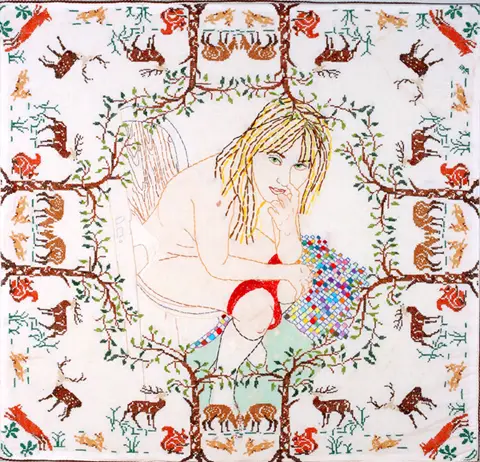Every project uses thread. We need them to stitch, sew, embroider, embellish, and weave. We play with thread colors like they are textile crayons, using them to bring our creative thoughts to vivid life. We can pick different kinds of threads for different effects, or combine them with various stitches to make our projects more interesting. Let’s take these wonderful tools a step further, however. Let’s change the threads themselves. Play with them, deconstruct, modify, rework them, and have some fun.
Here are four ideas for altering threads and using them in your projects:
Intentionally fray the end
Some threads are naturally going to separate at the end. It’s time to make this work for you by using it for creative embellishments. Fray a thread (like Kreinik Braids or Ribbons, for example) to make tassels, create a fuzzy effect in a stitch, replicate hair (how fun is metallic hair?), or invent other texture ideas. Simply take your finger and tap the end of the thread to separate the strands, then use a straight pin or needle to gently pull apart the fibers.

Rickrack and ruche it
This is one of my favorite techniques for altering Kreinik 1/16″ and 1/8″ Ribbons. Rickrack is a flat ribbon that zigzags. Ruching is a technique where you gather ribbons to form ruffles; it’s basically rickrack pulled all the way together. Both can be tacked to your needlework for some gorgeous special effects. As with the fraying technique, tap the end of the thread to separate the strands, then gently pull one fiber slowly, causing the rest of the ribbon to fold in on itself. Work the zigzags or “pleats” down the length of your fiber as you keep pulling the one strand. Pull all the pleats together tightly to ruche it. This thread version makes a nice bow on a stitched package, or a flower center, or any other ruffly effect.


Overdye a thread
If you’ve ever tie-dyed a t-shirt, or had a mood ring, kaleidoscope or lava lamp, you know how much fun it is to change colors. Overdyed threads are popular now — you get a unique, variegated look from your stitches — and you can find them in cotton, silk, wool and metallic threads, in floss, ribbons, and braids. If you are dyeing at home, test your thread on a swatch to see if it bleeds before stitching your heirloom. I suggest just leaving the messiness to the professionals and pick up some of the overdyed threads on the market. We love Threadworx and their overdyed versions of Kreinik metallic threads.

Hot-wire it
Wired threads are popping up everywhere, aiding and abetting surface embellishment. The wire helps you control the thread as you couch it down, or, if the wire is heavy enough, allows you to create sticking-out points to impress your friends. This is ideal for stitching words, or just making a design 3-dimensional. Kreinik now manufactures Kreinik Facets™ and Medium #16 Braid™ metallic thread with wire in them, but you can also add wire to other sizes of Kreinik Braid, or any other thread that will let you get into its core. Choose fine-gauge craft wire or thin florist wire, and work it into the center of your thread. On your fabric, sink the ends to the back of your work, and couch the fiber on the top of your design. I like to wrap the ends tightly with clear tape, which keeps the end from raveling and makes a sort-of tape-needle, which is easy to push through dense fabric.


Many good things have come from a creative person thinking, “I wonder what I can do with that.” Every once in awhile we all need to step back and look at things anew. So let me encourage you to view threads for what they can do as they are, and what they can do if you started playing with them a little bit. Don’t be afraid of a thread. I know you’ve spent money on it; that’s ok, you need to use it. Thread that is sitting unused in your stash isn’t worth much. Use it, abuse it, alter it, and let your creativity take over. It’s liberating, and pretty fun. And pretty, actually.

—–
Dena Lenham, aka KreinikGirl, is Creative Director at Kreinik Manufacturing Company, a family-owned, USA-based business that manufactures high-quality yarns and threads made of metallics, silks and real metals from their West Virginia factory.




